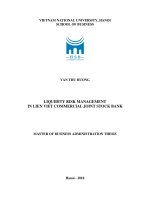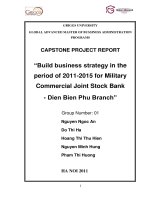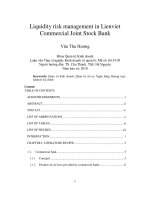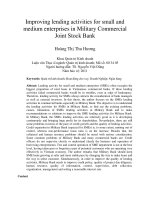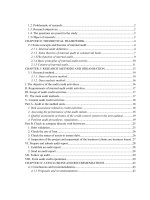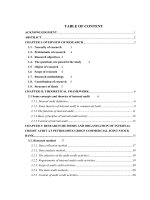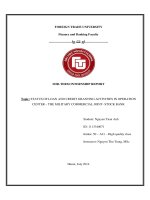Model for risk quantification in guaranteed asset at asia commercial joint stock bank
Bạn đang xem bản rút gọn của tài liệu. Xem và tải ngay bản đầy đủ của tài liệu tại đây (997.39 KB, 112 trang )
..
RESEARCH PROJECT
BMBR5103
Model for Risk Quantification in Guaranteed Asset Valuation
at Asia Commercial Joint Stock Bank
STUDENT’S FULL NAME
: THANH QUANG TRUNG
STUDENT ID
: CGS00018500
INTAKE
: SEPTEMBER, 2014
ADVISOR’S NAME & TITLE
: ASSOC.PROF.DR. PHAN DINH NGUYEN
December, 2015
1
Advisor’s assessment
............................................................................................................................................
............................................................................................................................................
............................................................................................................................................
............................................................................................................................................
............................................................................................................................................
............................................................................................................................................
............................................................................................................................................
............................................................................................................................................
............................................................................................................................................
............................................................................................................................................
............................................................................................................................................
............................................................................................................................................
............................................................................................................................................
............................................................................................................................................
............................................................................................................................................
............................................................................................................................................
Advisor’s signature
2
ABSTRACT
The thesis "Model for Risk Qualification in Guaranteed Asset Valuation
at Asia Commercial Joint Stock Bank" aims to identify the factors that cause
valuation risks of guaranteed assets, quantify probability of risks and identify
important factors that influence valuation risks of guaranteed assets, and last but
not least propose measures to minimize risks and remedy losses from such risks.
Thesis provided points of view, the existence of risk, identification,
assessment and study of valuation risks of guaranteed assets. To identify and
assess the valuation risks of guaranteed assets, Thesis built a factor analysis
model and used linear regression analysis to find out which factors cause
valuation risks of guaranteed assets.
Additionally an assessment scale of the valuation risks of guaranteed
assets was created. The scale of valuation risks includes 22 variables and scores
similarly to Likert scale and its reliability is tested by Cronbach's Alpha.
Some new points of the thesis include the application of risk scale in
valuation of guaranteed assets, creation of a factor analysis model and the use of
linear regression analysis to identify all the factors resulting in valuation risks of
guaranteed assets.
Based on results of the regression analysis, the thesis proposed some
solutions and recommendations to minimize risks and overcome losses resulting
from such risks.
3
Contents
ABBREAVIATIONS .............................................................................................................................................. 5
LIST OF FIGURES ................................................................................................................................................ 7
LIST OF TABLES .................................................................................................................................................. 8
CHAPTER ONE ..................................................................................................................................................... 9
INTRODUCTION .................................................................................................................................................. 9
1.1 Background of the study .................................................................................................................................. 9
1.2 Research Objectives ........................................................................................................................................ 12
1.3 Research questions .......................................................................................................................................... 13
1.4 Scope of the study ........................................................................................................................................... 13
LITERATURE REVIEW .................................................................................................................................... 15
2.1 Definition of relevant concepts ...................................................................................................................... 15
2.2 Factors leading to valuations risks ................................................................................................................ 17
2.3 Risk management in valuation ...................................................................................................................... 19
CHAPTER THREE: RESEARCH METHODOLOGY .................................................................................... 24
3.1 Research Design .............................................................................................................................................. 24
3.2 Qualitative method ......................................................................................................................................... 25
3.3 Quantitative method ....................................................................................................................................... 25
3.4 Data Resource ................................................................................................................................................. 27
3.5 RESEARCH SAMPLES ................................................................................................................................ 29
3.6 ADJUSTMENTS OF RESEARCH MODEL ............................................................................................... 29
3.7 CREATION OF MEASUREMENT SCALES ............................................................................................. 31
DATA ANALYSIS AND RESULTS ................................................................................................................... 36
4.1 INTRODUCTION .......................................................................................................................................... 36
4.2 ASSESSMENT ON MEASURING SCALE ................................................................................................. 36
4.3 TESTING MEASURING SCALE ................................................................................................................. 39
4
4.4 ANALYSIS OF FACTORS ............................................................................................................................ 41
4.5 MULTIVARIATE REGRESSION ANALYSIS .......................................................................................... 48
CHAPTER V - SOLUTIONS AND RECOMMENDATIONS ........................................................................ 56
5.1 SPECIFIC SOLUTIONS TO LIMIT RISKS IN BUSINESS ON PRICE VERTIFICATION OF
SECURED ASSETS ............................................................................................................................................. 56
5.2 GENERAL SOLUTIONS TO LIMIT RISK IN BUSINESS ON VALUATION OF SECURED ASSETS
................................................................................................................................................................................ 58
5.3 RECOMMENDATION .................................................................................................................................. 62
CONCLUSION ..................................................................................................................................................... 66
APPENDICES ....................................................................................................................................................... 72
APPENDIX 1: QUESTIONNAIRE ..................................................................... Error! Bookmark not defined.
APPENDIX 2: RELIABILITY ANALYSIS ....................................................... Error! Bookmark not defined.
5
ABBREAVIATIONS
ACB: Asia Commercial Joint Stock Bank
RE: Real estate
CRE: Comparable real estate for
VRE: Valuated real estate
CA: Cronbach's Alpha
EFA: Exploratory Factor Analysis
B: Bank
V: Price Valuation
CJS: Commercial Joint Stock
GA: Guaranteed Assets
6
LIST OF FIGURES
Figure 2.1: Initial theoretical research model
Figure 3.1: Research Process
Figure 3.2: Research model
Figure 4.1: Frequency of standardized residuals
7
LIST OF TABLES
Table 3.1: Scale of Risks in Business Valuation
Table 3.2: Scale of Objects in Valuation
Table 3.3: Scale of Operating Environment of the organization
Table 3.4: Scale of Valuer's Awareness
Table 3.5: Scale of Information Environment
Table 3.6: Scale of Legal Environment
Table 4.1: Statistical results of variables affecting valuation risks
Table 4.2: Test results of scales
Table 4.3: Test results of KMO and Bartlett's Test of Sphericity of Scales
Table 4.4: Table of Communalities (Factor Loading)
Table 4.5: Initial Eigenvalues in Total Variance Explained
Table 4.6: Rotated component matrix
Table 4.7: Interpretation of factors affecting risk level in valuation of Asia
Commercial Joint Stock Bank
Table 4.8: Independent variable included in regression analysis
Table 4.9: Results of multivariate regression
8
CHAPTER ONE
INTRODUCTION
1.1 Background of the study
There are many important studies in the world related to the valuation of
real estate for various purposes. The research "Estimating Land Values" by
Ted Gwartney Arden and Delaware in July 1999 is a typical instance. In
their research, the authors studied and introduced a number of principles as
well as methods for determining the value of land. In her "EMS and Land
Valuation" research, Catherine Nind (2002) mainly referred to the
assessment of land values taking into account of environmental factors.
Catherine Nind focused on methods for determining the values of land
resources based on ensuring environmental factors. By studying market
transactions of real estate in the period from 1994 - 2000 and effects of
values of real estate for mortgage on Nigerian credit institutions' lending
activities, Aluko and Bioye Tajudeen concluded that the market values of
real estate were a fundamental basis for estimating values of mortgaged real
estate. The authors applied multiple regression models to estimate market
values of mortgaged real estate. This value will constitute the maximum
limits that credit institutions should not exceed to avoid risks for lending
activities. However, in those studies, the authors only pointed out that such
prices would not be maintained in the future. The authors also concluded that
lending rates for mortgages depended significantly on the development of
real estate market at the time of valuation and valuer's views on values.
Therefore, the appraised values are temporary only. Any movements out of
valuation time will affect the appraised values of real estate. Kwong Chaw,
9
Wailai (2002) studied valuation methods for real estate as guaranteed assets
for loans at banks and credit institutions of China. This research mainly
focused on methods applied to valuation of mortgage. Particularly, Kwong
Chaw and Wailai studied deeply into two basic methods including costbased and income-based methods for determining values of mortgaged real
estate. According to them, values of real estate would be calculated based on
their constituted incomes and costs. Nevertheless, the two authors only
identified valuation methods not process or organization for valuation of
mortgaged real estate. In general, these studies were conducted with
relatively complete information and applied in a close legal system.
In Vietnam, there are also a number of research topics related to real
estate valuation. In his "Model for Risk Qualification in Asset Valuation"
thesis for Economic Master Degree, Nguyen Khanh Tuyen presented his
views on the existence of risk and identification, assessment and study of
valuation risks of appraisal firms. To identify and assess the valuation risks
of guaranteed assets, he built a factor analysis model and used linear
regression analysis to find out which factors cause risks in valuation as well
as probability of each profile for valuation.
He also built a unidirectional scale of risk assessment in valuation.
Additionally an assessment scale of the valuation risks of guaranteed assets
was created. The scale of valuation risks includes 15 variables and scores
similarly to Likert scale and its reliability was tested by Cronbach's Alpha;
unidirectional property of scale was also confirmed through factor analysis.
Some new points of this thesis included the application of risk scale in
valuation, application of factor analysis and linear regression analysis
together with non-linear relationships to identify main factors affecting
valuation risks and risk probability of each profile for valuation.
10
In addition, the authors also refered to other following documents:
Ministerial scientific research topics:
“Khả năng áp dụng một số phương pháp xác định giá trị quyền sử dụng
đất góp phần lành mạnh hóa thị trường quyền sử dụng đất ở Việt Nam” (The
ability to apply some methods of land use right valuation to creat a healthy
market of land use rights in Vietnam") by Nguyen Manh Hai.
“Ứng dụng phương pháp lý thuyết vị thế - chất lượng trong định giá
BĐS” ("Application of position - quality theoretical methods in real estate
valuation") by Nguyen Manh Hung, Tran Van Trong, Ly Hung Thanh and
Tran Huu Phe.
Pham Thi Ngoc My's Doctoral thesis “Các giải pháp thúc đẩy sự phát
triển thẩm định giá ở Việt Nam trong những năm tới” ("Solutions to promote
the development of valuation in Vietnam in the coming years.")
Ngo Thi Phuong Thao's Doctoral Thesis “Định giá bất động sản thế chấp
trong các ngân hàng thương mại Việt Nam” ("Valuation of mortgaged real in
commercial banks of Vietnam").
Nguyen Duc Kim's research “Hoạt động thẩm định giá trong việc quản
lý nợ xấu tại hệ thống ngân hàng thương mại Việt Nam” ("Valuation in the
management of bad debts in commercial banking system of Vietnam")
Nguyen Thi Thu Thuy's Master thesis “Công tác thẩm định giá tài sản
đảm bảo là nhà ở tại ngân hàng TMCP An Bình khu vực phía Bắc”
("Valuation of guaranteed assets in An Binh Commercial Joint Stock Bank
in the North Area")
Huynh The Du's research “Tại sao tài sản đảm bảo là yếu tố quan trọng
trong quyết định cấp tính dụng của các tổ chức tín dụng Việt Nam” ("Why
guaranteed assets plays
important role in lending decisions of credit
organizations in Vietnam").
11
“Vấn đề tài sản đảm bảo tại các ngân hàng thương mại Việt Nam hiện
nay” ("Guaranteed assets in commercial banks of Vietnam today"by Ho
Thien Thanh, Nguyen Chi Duc)
Briefly, no authors have studied deeply into Model for Risk Qualification
in Guaranteed Asset Valuation at Asia Commercial Joint Stock Bank.
1.2 Research Objectives
1.2.1 General Objective
Guaranteed assets valuation for mortgage purposes is one of the essential
skills before granting credit of commercial banks. Along with the
development of the economy in general and the banking system in particular,
values of guaranteed assets will influence lending decisions of the banks.
Therefore, valuation of guaranteed assets at commercial banks plays a
significant role.
However, it is a fact that valuations of guaranteed assets in commercial
banks are still loose and many existing risks may result in bad debts. In June
2013, according to the State Bank of Vietnam, bad debt ratio of the whole
banking system was 4.68% of total loans. Beside commercial banks are also
weak at qualifications, professional skills and administrative capacity. In
addition, social awareness of evaluation (appraisal) is limited. Despite many
adjustments, legal frameworks governing valuation are still inconsistent and
incomplete, particularly in commercial banks. As a result, there are many
valuation risks of guaranteed assets in commercial banks.
Therefore, valuation of guaranteed assets in commercial banks are
required to identify risk level involved in evaluation of existing or future
profiles to give appropriate responses for each valuation profile.
12
As a valuer of a commercial bank and for the reasons stated above as
well as the completion of his/her graduation thesis and, the authors chose
topic: "Model for Risk Qualification in Guaranteed Asset Valuation at Asia
Commercial Joint Stock Bank".
1.2.2 Specific Objectives
This study has the following specific objectives:
- Identifying factors affecting valuation risks of guaranteed assets at Asia
Commercial Joint Stock Bank.
- Identifying influence extent of each factor affecting valuation risks of
guaranteed assets at Asia Commercial Joint Stock Bank.
- Proposing overall solutions for commercial banking industry and
particularly to Asia Commercial Joint Stock Bank to minimize valuation
risks of guaranteed assets.
1.3 Research questions
The main research question in this study is defined as follows:
(1) What is Guaranteed Asset Valuation of Bank?
(2) What is factors affect Guaranteed Asset Valuation of Bank?
(3) How to improve the quality of Guaranteed Asset Valuation of Bank?
1.4 Scope of the study
Study subjects were identified as: Qualification in Guaranteed Asset
Valuation at Asia Commercial Joint Stock Bank
Scope of the study: The thesis "Model for Risk Qualification in
Guaranteed Asset Valuation at Asia Commercial Joint Stock Bank" aims to
identify the factors that cause valuation risks of guaranteed assets, quantify
probability of risks and identify important factors that influence valuation
13
risks of guaranteed assets, and last but not least propose measures to
minimize risks and remedy losses from such risks.
14
CHAPTER TWO
LITERATURE REVIEW
2.1 Definition of relevant concepts
2.1.1 VALUATION
According to Oxford Dictionary: "Valuation is a professional judgment
about how much money something is worth; its estimated value".
According to Professor W. Seabrooke (1998) - University of Portsmouth,
UK: "Valuation is the estimated value of the ownership of specific assets in
the form of currency for an identify purpose".
Marketing Director of AVO, Fred Peter Marrone (2010) claimed,
"Valuation is the process of collecting and analyzing the market value
combined with comparing to required property appraisal". Therefore,
valuation is the application of market data that the valuers gather and
analyze, and then compare with the valuated property to identify their
values".
In another definition, Professor Lim Lan Yuan (2012) considered that
valuation is a scientific estimate a value for the specific purpose of a
particular asset at a specified time, taking into account all the characteristics
of the properties as well as considering all the basic economic factors of the
market, including the types of investment options.
According to the Price Ordinance No. 40/2002/PL-UBTVQH10 in 2002
of Vietnam, valuation is defined as an assessment or a reassessment of asset
values consistent with the market in a place and given time by the standards
of Vietnam or international practice.
Overall, all the definitions as mentioned above valuation share some
following elements:
15
- Estimating present values of property (property rights)
- Calculating by the same form of cash.
- Following the main request, the purpose is predetermined
- At the specific time, places and objects
- Using the database, market or non-market factors.
2.1.2 RISKS IN VALUATION OF GUARANTEERED
ASSETS
Risks in Valuation
It is widely recognized that valuation has its own risks. The concept of
risk in valuation may be identified as following:
"Valuation risks due to uncertainty in measurement can result in
damages, losses or loss of lucrative opportunities. However, they can also
lead to benefits, favorable opportunities in valuation."
Risks in valuation of guaranteed assets
- Risk is an objective and unforeseen phenomenon that can occur
anytime, anywhere, in any field.
- The more Vietnam's banking system as well as commercial banking
system grows, the more risks appear to it.
- Valuation of guaranteed assets appeared in Vietnam at the request of
market economy only a few years ago meanwhile it has been developed for
such a long time in other developing and developed countries. Therefore,
due to the lack of experience, this activity shall face many difficulties as well
as risks.
- Limited and incomplete legal system of Vietnam on valuation of
guaranteed assets; Loose and imperfect operation regulations and
organization of valuation firms; adequate number of qualified valuers.
16
- Services provided and coordinated with valuation such as provision of
information of price, quality, specifications, legal profiles of assets is still
very primitive, monotonous; even in some of the services have not been
formed.
Necessity for research on valuation risk
In valuation of guaranteed assets, the occurrence of risks often results in
damages and losses to people involved especially banks. Therefore, banks
are urgently required to apply necessary methods for identifying, controlling,
preventing and minimizing such damages, losses and adverse effects of
risks. Furthermore, it is also necessary to review valuation process to
propose schemes and scenarios to predict possibility of success and
unforeseen failure.
An assessment of risk level in valuation, even only relative, will help
bank administrators to suggest measures to minimize harmful effects of
risks. Especially, in case valuation firms have found subjective factors that
contribute to risks, they can introduce measures to minimize subjective risks.
If risks in valuation of guaranteed assets only occur with low frequency
and due to objective factors, banks or valuers themselves can limit the risks
by taking economic or occupational measures. However, once risks in
valuation occur with high frequency and due to internal factors of banks, the
situation has become more serious that forces banks to adopt overall
solutions to reform banking activities or otherwise they face the risk of
bankruptcy.
2.2 Factors leading to valuations risks
Valuated objects
17
- Incomplete legal documents of valuated objects (certificates of land use
rights, ownership of houses and other assets attached to the land,
declarations for registration fee, certificates of planning, construction
permits, drawings, etc.).
- Nonequivalence between specification of valuated objects and
comparable properties (too large or too small area or scale, too favorable or
too unfavorable locations, too modern or too backward technology and
construction materials (for real estate)); too high or too low capacity, too
advanced or too outdated production technology, etc. (For machinery)).
- Unfavorable infrastructure conditions.
- Unfavorable planning.
Operating environment of the organization
- Different views of banks on valuation of guaranteed assets.
- Limited time for processing profiles (or simultaneous processing of
many profiles).
- Remuneration policy for valuers.
- Inappropriate valuation organization and regulations.
Awareness of valuers
- Leaders of banks orient in advance the values of valuated objects (for
personal intrigue).
- Valuer's intention (for personal intrigue or awareness).
- Valuer's failure to master professional skills.
Economic environment
- Superficial and inaccurate valuation due to imposition of low fees or no
fee on service and valuated objects.
- Too great value of valuated objects.
18
- Low cost of buying information (leading to inappropriate and
inaccurate information).
- Unfavorable commercial conditions.
- Market fluctuations.
Information environment
- No use of expert opinions from valuers
- Inaccurate provision of information.
- Incomplete construction of information systems.
Legal Environment
- Weak and unclear legal systems and policies on valuation.
- Failure to fully understand law.
2.3 Risk management in valuation
Research on risks and risk management aims to identify, analyze, control,
prevent and minimize risks and their damages. Risk management is a
scientific process to achieve the best results and consent among people
concerned.
According to Assoc. Professor Doctor Doan Thi Hong Van (In her book
called "Risk Management and Crisis", Statistical Publishing House, 2005),
risk management is a scientific, comprehensive and systematic approach to
risks in order to identify, control, prevent and reduce the damages, losses and
adverse effects of risks ".
The process of risk management in valuation includes:
- Identification, analysis and measurement of risks;
- Control and prevention of risks;
- Remedy of risks.
Identification of risks in valuation
19
Identification of risk in valuation is continuous and systematic
determining of risks in valuation. Risk identification in valuation intends to
develop information on the sources and objects of risk, risk factors that cause
risks and types of losses.
Risk identification in valuation includes tracking, reviewing, studying
operational environment and the entire operation activities of valuation
industry and valuation companies to identify and make lists of all the
valuation risks. This process not only identifies risks that has occurred but
also predicts the risk of new types that may appear and proposes appropriate
measures for controlling and financing risks.
Risk identification is the first essential step in the process of risk
management.
Risk identification methods
To identify risks, following methods are frequently applied:
- Preparation of questionnaires of risks that adapt to activities of the
organization and conducting investigations and research.
- Analysis of financial statements to determine risks of organizations in
terms of assets, human resources and legal liabilities.
- Flowchart: based on flow chart that shows operations of the
organizations, it is possible to list risks of properties, human resources and
legal liabilities.
In this thesis , for qualitative research, the thesis combined methods to
explore, adjust and complement his/her scale of risks in valuation of
guaranteed assets. Meanwhile, in qualitative research, the thesis mainly used
research questionnaires and then applied regression analysis model to factors
that pose valuation risks of guaranteed assets.
Risk classification
20
There are many types of risks and the newly appeared types seem to be
increasingly complicated. There are many different criteria used in risk
classification such as classification by sources of risks, nature, impacting
environments, impacting objects, etc. The most common method is the first
one - classification by sources of risks.
Within this thesis , the thesis also classifies risks in valuation base on this
method.
Based on sources of risks in valuation, risks are divided as following:
- Risks from natural environment: Risks in this group are resulted from
natural phenomenon and often lead to enormous losses in both human life
and properties.
- Risks from cultural environment: The lack of understanding of customs
and habits of other different ethnic groups and localities leads to
inappropriate behaviors that cause damages or losses.
- Risks from social environment: Risks of this type are resulted from
changes in value standards, human behaviors, social structures and
institutions.
- Risks from political environment: Risks originated from changes in
political environment, or government.
- Risk from legal environment: Risks arise from legal system. Norms of
the law insistent with society's progress, or failure to fully understand laws
due to too many changes.
- Risks from economic environment: Risks resulted from economic
environment. Great scale of the world economy and such issues as economic
growth, crisis, recession, inflation, exchange rates, interest rates, price, etc.
- Risk from operational environment of the organization: Risks
originating from organizational activities such as process, apparatus,
21
organizational culture, employee benefits, customer relations, competitors,
leadership psychology.
- Risks from human awareness: Risks resulted from inaccurate awareness
and analysis or imposing subjective intentions of valuers.
Analysis and measurement of risks in valuation of guaranteed assets
After risk identification, it is required to analyze risks, measure the
overall level of risks, determine the severity of causes of such risks to work
out restrictive measures and prevent adverse effects. In this process,
frequency and severity of effects of risks will be clarified.
This will be comprehensively discussed in the next parts of the thesis to
build a quantification model for risks and analysis of the factors affecting
valuation risks of guaranteed assets.
Control and prevention of risks in valuation
In this step, technical measures and action plans are used to restrict and
prevent adverse effects of risks. This step is the focus of risk management.
Basic measures in risk control and prevention:
- Risk prevention
- Loss prevention
- Loss minimization
- Risk transfer
- Risk diversification
Remedy of risks in valuation
In case of occurrence of risks, it is urgent to determine losses in terms of
assets, human resources and legal liabilities. Then appropriate remedy
solutions shall be adopted.
- Self-remedy of risks. The organization suffering from risks makes all
payment and overcomes the losses by its own capital.
22
- Risk transfer: The organization suffering from risks shall transfer part
or all of the losses to another organization based on the contract signed
previously such as insurance companies, consulting and surveying
organizations, any organizations have agreed to performance.
23
CHAPTER THREE
RESEARCH METHODOLOGY
3.1 Research Design
Research Process
BACKGROUND
RESEARCH
OBJECTIVES
THEORICAL
BACKGROUND
RESEARCH
METHODOLOGY
EXPERT INTERVIEWS
QUALITATIVE
RESEARCH
PREPARATION OF
QUESTIONNAIRE
CRONBACH ALPHA
EXPLORATORY
FACTOR ANALYSIS
(EFA)
QUANTITATIVE
RESEARCH
REGRESSION
MULTIVARIATE
RISK ASSESSMENT OF
VALUATION
CONCLUSIONS
SOLUTIONS
Figure 3.1: Research Process
24
3.2 Qualitative method
Preliminary steps were used to explore, adjust and supplement the
scale. Furthermore, technical exchange and direct discussions with valuers
and experts were used to find out causes of risk factors in valuation. The
original questions were designed as open questionnaire to gather additional
relevant variables from valuers and experts.
This step aims to explore new variables observed to supplement to the
research model and at the same time eliminate variables unsuitable for
valuation of guaranteed assets so that the thesis
could create a proper
questionnaire for official research.
Objects for discussions and interviews were valuers and experts, and
managers in this field in order to identify risks in valuation and manager's
awareness of risks in valuation.
3.3 Quantitative method
3.3.1 Objectives
The objective of quantitative research was to measure valuation risks
of guaranteed assets for the elements identified in qualitative research.
3.3.2 Data collection procedures
Quantitative data were collected through interviews with valuers via
detailed questionnaires designed consistent with research objectives. The
questionnaire was first designed based on the results of qualitative research.
Then, the questionnaire was included in trial interviews with 10 valuers
before conducting formal research. Trial interviews were used to correct
errors, if any, or elements causing confusion for interviewees.
3.3.3 Data analysis procedure
25
